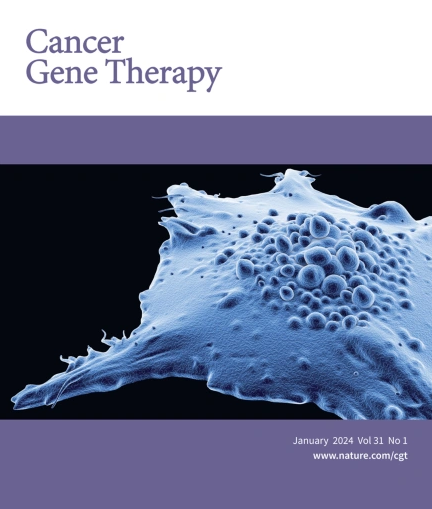AAV-mediated combination gene therapy of inducible Caspase 9 and miR-199a-5p is therapeutic in hepatocellular carcinoma
IF 4.8
3区 医学
Q1 BIOTECHNOLOGY & APPLIED MICROBIOLOGY
引用次数: 0
Abstract
Advanced-stage hepatocellular carcinoma (HCC) remains an untreatable disease with an overall survival of less than one year. One of the critical molecular mediators contributing to increased resistance to therapy and relapse, is increased hypoxia-inducible factor 1α (HIF-1α) levels, leading to metastasis of tumor cells. Several microRNAs are known to be dysregulated and impact HIF-1α expression in HCC. An in silico analysis demonstrated that hsa-miR-199a-5p is downregulated at various stages of HCC and is known to repress HIF-1α expression. Based on this analysis, we developed a combinatorial suicide gene therapy by employing hepatotropic Adeno-associated virus-based vectors encoding an inducible caspase 9 (iCasp9) and miR-199a. The overexpression of miR-199a-5p alone significantly decreased ( ~ 2-fold vs. Mock treated cells, p < 0.05) HIF-1α mRNA levels, with a concomitant increase in cancer cell cytotoxicity in Huh7 cells in vitro and in xenograft models in vivo. To further enhance the efficacy of gene therapy, we evaluated the synergistic therapeutic effect of AAV8-miR-199a and AAV6-iCasp9 in a xenograft model of HCC. Our data revealed that mice receiving combination suicide gene therapy exhibited reduced expression of HIF-1α ( ~ 4-fold vs. Mock, p < 0.001), with a significant reduction in tumor growth when compared to mock-treated animals. These findings underscore the therapeutic potential of downregulating HIF-1α during suicide gene therapy for HCC.

AAV介导的诱导型Caspase 9和miR-199a-5p联合基因疗法可治疗肝细胞癌。
晚期肝细胞癌(HCC)仍然是一种无法治疗的疾病,患者的总生存期不到一年。导致耐药性增加和复发的关键分子介质之一是缺氧诱导因子 1α (HIF-1α)水平升高,从而导致肿瘤细胞转移。已知有几种微RNA会失调并影响HCC中HIF-1α的表达。一项硅学分析表明,hsa-miR-199a-5p 在 HCC 的不同阶段都会出现下调,并抑制 HIF-1α 的表达。基于这一分析,我们开发了一种组合式自杀基因疗法,采用了基于肝脏腺相关病毒的载体,编码诱导型caspase 9(iCasp9)和miR-199a。单独过表达 miR-199a-5p 能显著降低(与 Mock 处理细胞相比降低约 2 倍,p
本文章由计算机程序翻译,如有差异,请以英文原文为准。
求助全文
约1分钟内获得全文
求助全文
来源期刊

Cancer gene therapy
医学-生物工程与应用微生物
CiteScore
10.20
自引率
0.00%
发文量
150
审稿时长
4-8 weeks
期刊介绍:
Cancer Gene Therapy is the essential gene and cellular therapy resource for cancer researchers and clinicians, keeping readers up to date with the latest developments in gene and cellular therapies for cancer. The journal publishes original laboratory and clinical research papers, case reports and review articles. Publication topics include RNAi approaches, drug resistance, hematopoietic progenitor cell gene transfer, cancer stem cells, cellular therapies, homologous recombination, ribozyme technology, antisense technology, tumor immunotherapy and tumor suppressors, translational research, cancer therapy, gene delivery systems (viral and non-viral), anti-gene therapy (antisense, siRNA & ribozymes), apoptosis; mechanisms and therapies, vaccine development, immunology and immunotherapy, DNA synthesis and repair.
Cancer Gene Therapy publishes the results of laboratory investigations, preclinical studies, and clinical trials in the field of gene transfer/gene therapy and cellular therapies as applied to cancer research. Types of articles published include original research articles; case reports; brief communications; review articles in the main fields of drug resistance/sensitivity, gene therapy, cellular therapy, tumor suppressor and anti-oncogene therapy, cytokine/tumor immunotherapy, etc.; industry perspectives; and letters to the editor.
 求助内容:
求助内容: 应助结果提醒方式:
应助结果提醒方式:


